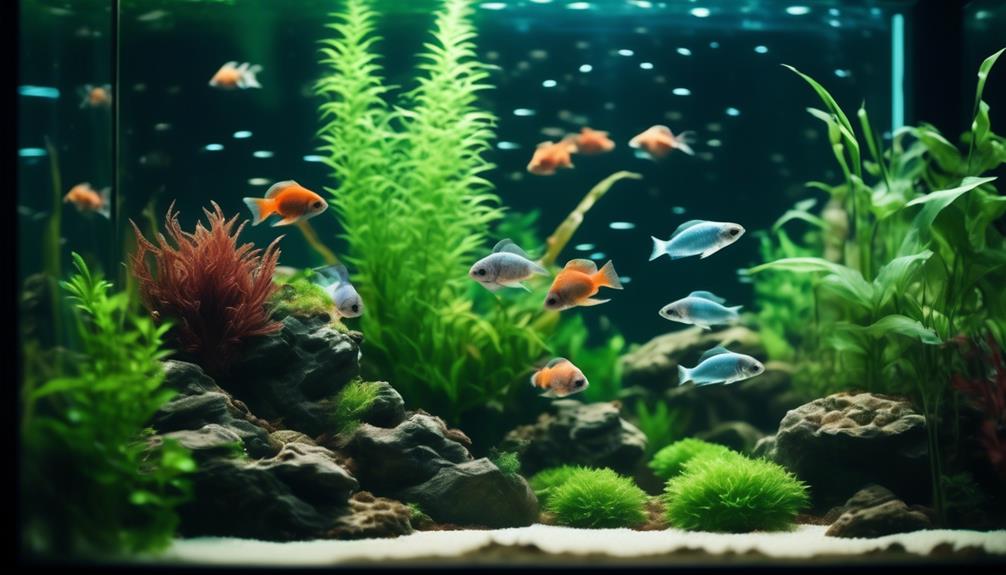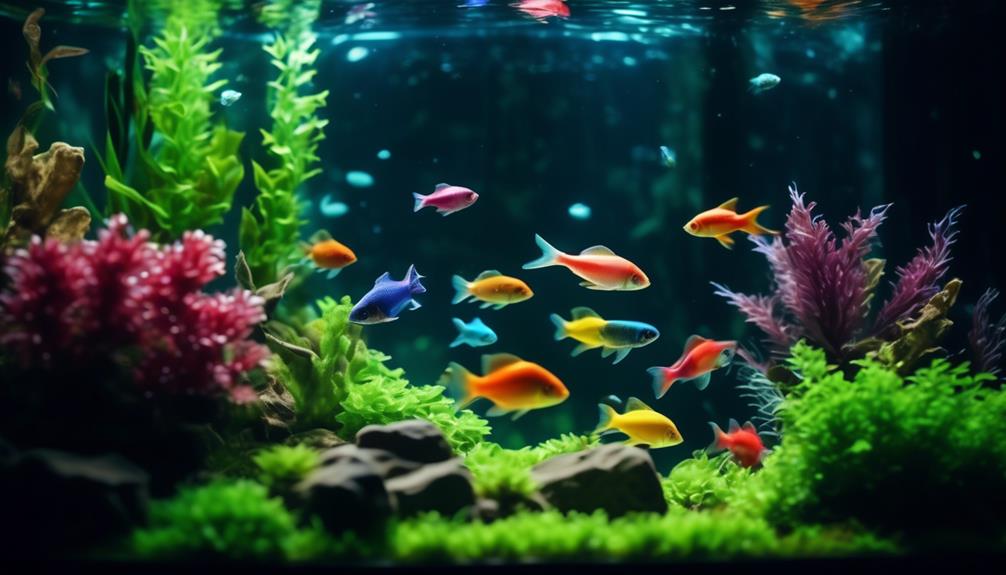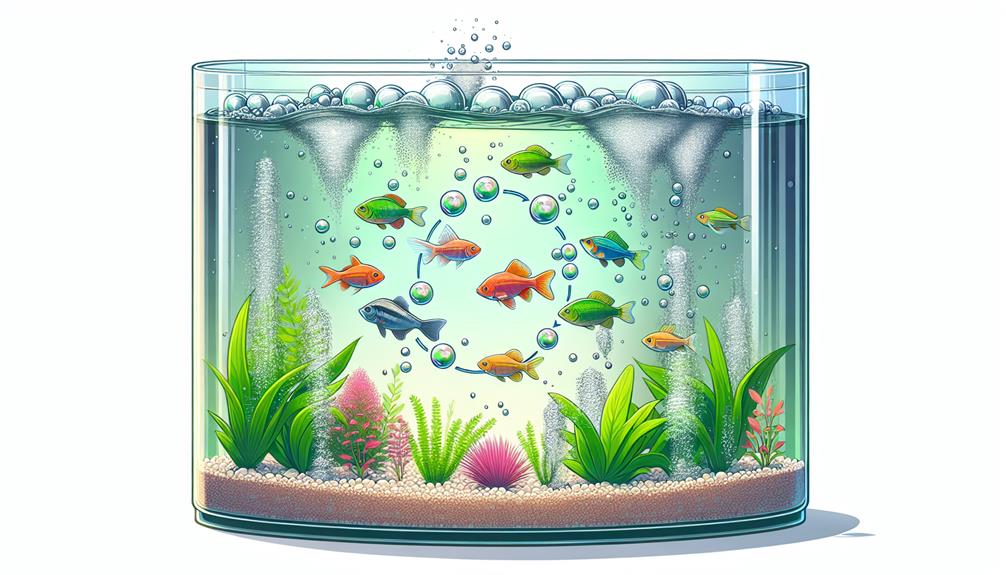Maintaining a healthy and vibrant aquarium is a goal that every fish enthusiast aspires to achieve. One crucial aspect of achieving this is mastering the aquarium nitrogen cycle.
The nitrogen cycle is a complex process that involves the conversion and consumption of nitrogen compounds by bacteria, plants, and animals. By understanding and effectively managing this cycle, aquarium owners can create a sustainable ecosystem that promotes the well-being of their fish.
In this article, we will explore various methods of cycling an aquarium, including fish-in cycling, cycling with plants, and fish-less cycling. We will also discuss the importance of regular water testing and maintenance.
So, if you're eager to discover the secrets behind a vibrant aquarium and ensure the health of your fish, stay tuned to uncover the key principles and strategies for mastering the aquarium nitrogen cycle.
Key Takeaways
- The aquarium nitrogen cycle is a natural process that helps maintain water quality by converting and recycling nitrogen compounds.
- Fish-In Cycling is a common approach where fish are gradually added to the aquarium over time, while monitoring water quality and doing partial water changes as needed.
- Cycling with live aquarium plants can create a natural ecosystem that effectively consumes nitrogen waste and indicates the completion of the cycle when new growth is observed.
- Fish-Less Cycling, although not recommended for beginners, involves using fish food or ammonia source to establish beneficial bacteria in an empty aquarium, requiring knowledge and experience in aquarium keeping.
Understanding the Nitrogen Cycle
The nitrogen cycle is a fundamental process in aquarium maintenance, playing a crucial role in the overall health and stability of the aquatic ecosystem. Understanding the nitrogen cycle is essential for aquarium owners who desire to serve their fish and maintain a thriving environment.
The benefits of the nitrogen cycle are numerous, with the most significant being the maintenance of water quality. By cycling ammonia into nitrite and then nitrate, beneficial bacteria convert harmful compounds and ensure the overall health of the aquarium. This process helps prevent fish loss and creates a stable environment for aquatic life.
Maintaining proper water quality is essential for the well-being of fish, as poor water conditions can lead to stress, disease, and even death. Therefore, understanding and managing the nitrogen cycle is of utmost importance in serving and caring for aquarium inhabitants.
Fish-In Cycling: Step-by-Step Guide
To successfully implement fish-in cycling in your aquarium, it is important to follow a step-by-step guide that ensures the gradual introduction of fish and the growth of beneficial bacteria. Here are the steps to follow for a successful fish-in cycling process:
- Start with a few hardy fish: Begin by adding a small number of fish to your aquarium. Hardy fish species are recommended as they are more tolerant of the initial ammonia and nitrite spikes.
- Feed the fish lightly and gradually increase the amount: In the beginning, feed your fish sparingly to minimize the production of excess waste. As the beneficial bacteria population grows, gradually increase the amount of food to sustain the fish.
- Monitor water quality regularly: Test the water parameters regularly using test strips or a test kit. Keep an eye on ammonia and nitrite levels, as well as pH, to ensure they remain within acceptable ranges.
- Perform partial water changes when necessary: If ammonia or nitrite levels rise to harmful levels, perform partial water changes to dilute the toxins. This helps maintain a healthier environment for your fish.
Cycling With Live Plants: a Natural Approach

Using live aquarium plants in the cycling process provides a natural and effective approach to maintaining water quality and creating a thriving ecosystem. Live plants offer numerous benefits for aquarium cycling, including the ability to consume nitrogen waste effectively. They play a crucial role in the nitrogen cycle by converting ammonia into nitrate through a process called nitrification. This helps to reduce the levels of toxic ammonia in the water, creating a healthier environment for fish. Additionally, live plants provide oxygen, remove excess nutrients, and reduce algae growth. When choosing plants for aquarium cycling, it is important to select species that are hardy and can tolerate a range of water conditions. Some popular choices include Anubias, Java Fern, and Amazon Sword. By incorporating live plants into the cycling process, aquarists can create a more natural and balanced ecosystem for their fish.
| Plant Name | Benefits for Aquarium Cycling |
|---|---|
| Anubias | Hardy, low light requirements, consumes ammonia, reduces algae growth. |
| Java Fern | Easy to care for, absorbs nutrients, provides shelter for fish fry. |
| Amazon Sword | Fast-growing, removes excess nutrients, adds visual appeal to the aquarium. |
Fish-Less Cycling: Advanced Method
In the realm of aquarium cycling, an alternative and advanced method known as Fish-Less Cycling offers a unique approach to establishing a healthy and balanced ecosystem without the presence of actual fish. This method involves using fish food or an ammonia source in an empty aquarium, and it requires knowledge and experience in aquarium keeping. Despite its challenges, Fish-Less Cycling offers several benefits:
- No harm to fish: With no fish present, there is no risk of exposing them to toxins during the cycling process.
- Controlled environment: Without fish, you have better control over water parameters, allowing for more precise adjustments and optimization.
- Faster cycling: By seeding the tank with beneficial bacteria using used filter media or bacteria additives, you can speed up the cycling process.
- Flexibility: Fish-Less Cycling allows you to choose the fish species that are best suited for your aquarium once the cycling process is complete.
However, there are potential challenges in Fish-Less Cycling, such as the need for regular monitoring of water parameters and the risk of overfeeding or underfeeding the tank. It is crucial to maintain a delicate balance of ammonia, nitrite, and nitrate levels to ensure a successful cycle.
With proper attention and care, Fish-Less Cycling can result in a vibrant and thriving aquarium ecosystem.
Tips for Successful Aquarium Maintenance

Regular and diligent maintenance is crucial for the successful upkeep of an aquarium ecosystem. To ensure a healthy and vibrant environment for your fish, here are some maintenance tips to follow.
- Regularly test the water parameters such as ammonia, nitrite, nitrate, pH, and temperature using a reliable test kit. This will help you identify any imbalances and take necessary actions.
- Additionally, perform regular water changes to remove accumulated toxins and replenish essential minerals.
- Clean the aquarium glass, decorations, and filters to prevent the buildup of algae and debris.
- Troubleshooting problems promptly is also important. If you notice any signs of disease or stress in your fish, take immediate action by isolating affected individuals and treating them accordingly.
Frequently Asked Questions
Can I Cycle My Aquarium Without Adding Any Fish or Ammonia Source?
Yes, it is possible to cycle an aquarium without adding any fish or ammonia source. An alternative method is to use live plants, which effectively consume nitrogen waste and create a natural ecosystem. This method benefits water quality and promotes a healthy environment for vibrant fish.
How Long Does It Typically Take for an Aquarium to Fully Cycle?
The length of time it takes for an aquarium to fully cycle can vary depending on several factors, such as the method used and the size of the tank. Typically, it can take anywhere from 4-8 weeks to establish a stable and balanced nitrogen cycle. It is possible to cycle an aquarium without adding fish or an ammonia source, but this method, known as fishless cycling, requires careful monitoring and the addition of a bacterial additive or used filter media to seed the tank with beneficial bacteria.
What Are Some Signs That My Aquarium Has Completed Its Cycling Process?
Some signs that your aquarium has completed its cycling process include zero ammonia and nitrite levels, presence of nitrates, and stable pH. It is important to continue monitoring water quality after cycling to ensure a healthy and vibrant fish environment.
Is It Necessary to Monitor Water Quality Regularly Even After the Cycling Process Is Complete?
Regular water testing is essential even after the cycling process is complete. It ensures the maintenance of a stable ecosystem and allows for early detection of any water quality issues, thereby preventing potential harm to the fish and promoting their vibrant health.
Are There Any Specific Types of Fish That Are More Suitable for Fish-In Cycling?
Fish-in cycling benefits include the ability to choose hardy fish species that can tolerate the cycling process. However, alternative methods for cycling, such as fishless cycling or cycling with plants, are also effective and may be more suitable for beginners.
Conclusion
In conclusion, mastering the aquarium nitrogen cycle is crucial for creating a vibrant and sustainable ecosystem for fish. Understanding the process and utilizing methods such as fish-in cycling, cycling with plants, and fish-less cycling are essential for maintaining water quality and ensuring the well-being of fish.
Regular water testing and maintenance are also important for the overall health of the aquarium. By following these principles, aquarium enthusiasts can create a thriving environment and enjoy the rewards of a healthy and vibrant aquarium.

